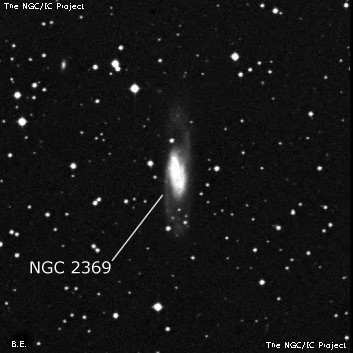
John Herschel discovered NGC 2369 = h3078 on 26 Dec 1834 and recorded "pB, E or irregular figure, glbM." His position (2 sweeps) is accurate.
Joseph Turner sketched this object on 15 Jan 1877 with the Great Melbourne Telescope as a thin streak oriented exactly N-S (unpublished plate V, figure 40) as well as Pietro Baracchi on 16 Mar 1885.
300/350mm - 13.1" (2/20/04 - Costa Rica): at 166x this Carina galaxy is fairly faint, fairly large, elongated 5:2 N-S, 1.7'x0.6', broad weak concentration but overall has a fairly low surface brightness (viewed at 16° elevation). In a group with NGC 2381 and NGC 2417.
600/800mm - 24" (4/11/08 - Magellan Observatory, Australia): at 260x appeared bright, large, very elongated 5:2 N-S, 2.4'x0.9', broad concentration with a slightly bulging middle. A 16th magnitude star is at the north end and a mag 15 star is just following the core. Nearly collinear with two mag 12/13 stars 2.5' and 3' NE. Brightest in a group with NGC 2381 48' SE, NGC 2369A 38' SE (on a line with NGC 2381), NGC 2369B 32' NE, NGC 2417 1.6° east and IC 2200/2200A 1.3° east.
Notes by Steve Gottlieb